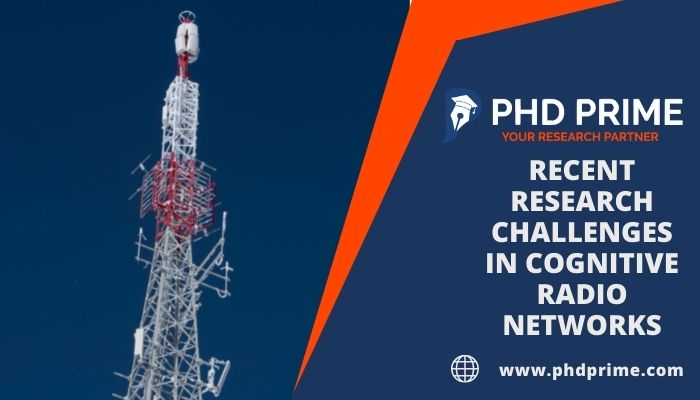A Cognitive Radio (CR) is a network that often senses and interacts with the surroundings to know the volatile spectrum handiness. It dynamically changes the network topology through dynamic spectrum handovers based on the user service requirements. In this article, you can get information on recent research challenges in cognitive radio networks!!!
In general, the two major components of CRN are the spectrum engine and policy engine. Here, the spectrum engine only collects the details about the available spectrum and decision to assign channels for services. Then, the policy engine follows up and processes the rules and regulations of CRN. As a unique property, the CRN utilizes frequency hopping to offer security. Also, it uses a proactive technique rather than using the reactive technique to hop among various channels. Now, we can see the important and fundamental operations of the CRN.

What are the functions of cognitive radio?
- Easy to identify the geo-positioning by using a transceiver
- Support the modification of modulation and transmit power features
- Ability to sense the environment to detect the nearby sensors/devices while processing
- Simple to perform user authentication and authorization processes
- Ensure the security of the signals by cryptographic functions (encode and decode)
Next, we can see the working flow of the cognitive radio mechanism in four different stages. Here, it senses the environment and detects the unused spectrum. Then it assigns the spectrum to the secondary users who need the spectrum.
Life Cycle for Cognitive Radio Network
- Sensing
- It sense the real-world environment for monitoring wideband radio frequency
- Analysis / Reasoning
- It performs the feature detection and characterization for generating appropriate responses for service request
- Adaptation
- Select the optimal response based on performance metrics
- Acting
- Enable secondary users to access the spectrum for communications
For more clarity, here we have given the process involved in the OSI layers. These functions are very important in developing CRN-related applications and systems. Below, we specified the physical layer, transport layer, link layer, network layer, and application layer.
OSI Stack for CRN
- Physical Layer
- Collect the sensing details
- Sense the available spectrum
- Manage the sensed data and reconfiguration
- Transport Layer
- Perform the reconfiguration process
- Manage the loss and handoff latency
- Link Layer
- Holds the scheduling data and reconfiguration
- Link-layer latency
- Network Layer
- Reconfigure the network in the case of dynamic changes
- Manage the route data for packet forwarding
- Application Layer
- Meet the needs of quality of services (QoS)
- Control and manage the whole application
Research Challenges in CRN
Now, we can see the key Research Challenges in Cognitive Radio Networks. These issues are very important when we deal with real-time applications. So, the current scholars seek effective solutions to break down these problems into pieces. Our researchers are ready to guide you in the following special cases. Further, if you are interested, we also let you know the other side of the current research areas.
- Theoretical Issues
- No efficient algorithms, tools and techniques
- Modeling Issues
- Require to solve the graph coloring issue in single-channel and multi-channel systems
- Not adaptive with varying channel-width contiguous channels
- Practical Issues
- Availability of unparalleled different spectrum
- Spectrum Fragmentation
- Designed Protocol need to be load-ware, efficiency-ware, opportunistic, distributed, and more
Detailed Research challenges of Cognitive Radio Network can be as follows.
- Spectrum Sensing:
- It is the foremost process of CRN to identify the available primary and secondary users to assign the unused spectrum to SUs without interfering with PUs
- For this sensing process, it focuses on several factors such as temporal metrics, power, modulation, frequency, etc. to identify the gaps in the spectrum band
- In the previous study, the sensing methods detect the energy and features in every narrow frequency band. But, it is not a promising strategy in terms of energy since it faces several interference and noise issues.
- Further, this technique also fails to identify and distinguish modulated signals, time-varying signals, frequency hopping signals, etc.
- To overcome the energy detector problem, cyclostationary models are proposed for feature detection. But, it has complexity in computation and requires more time
- Overall, the most challenging task in spectrum sensing is identifying the vulnerable primary signal in fast and low-cost environs.
- Advance Spectrum Management:
- In cognitive radio, we improve the spectrum consumption by letting unlicensed secondary users access the spectrum without affecting licensed primary users.
- The major issue in this process is dynamic power and spectrum allocation. So, we need to use adaptive access control techniques to automate this process efficiently
- In the previous study, heuristic methods are proposed which are not effective and centralized too.
- Unlicensed Spectrum Usage:
- There is an inconsistency in standard FCC spectrum distributions and real usage which indicates that a new approach to spectrum licensing is needed.
- So, it requires the adaptive technique to increase the spectrum access and provide efficient incentives for the unlicensed spectrum utilization
- Spectrum sharing strategies:
- It is the assignment of an unparalleled spectrum for the unlicensed service requests received from the users.
- Here, the interference aware opportunistic network faces many research challenges in cognitive radio networks in sharing of resources among multiple users.
- Spectrum sharing issues in primary and secondary users are unique than the traditional networks
- In specific, the secondary user’s spectrum access has an infinite number of research ideas
- Hidden node and sharing issues:
- For preventing the hidden node issue from the secondary user, we need to take effective defense measures to make sure that spectrum allocation does not affect the licensed primary users.
- Trusted access and security:
- Due to the distributed nature of the cognitive radios, it is essential to protect system security.
- Particularly to maintain the high-end security against the event attacks, application-specific privacy actions need to be taken in CRN
- Cross-layer design:
- CRN requires an advanced cross-layer approach to enhance its scalability nature.
- This approach needs to meet the requirements of network structure, physical link quality, radio node density/interference to manage the data sharing in a cross-layer system.
- In addition, it also has the threat of spectrum handoff in a dynamic cognitive radio environment. This can be prevented using an effective cross-layer design which ensures the QoS.
What is 5G cognitive radio?
In recent days, 5G is considered to be the dominating technology in communication due to its incredible benefits. Compare to 4G, 5G is vastly better in terms of low cost, high speed, low power usage, and more. On the other side, CRN is effective in independently allocating the spectrum in the time of huge network traffic and service requests for optimal interaction. These two sophisticated technologies are currently tied up together to rule mobile communication.
Conversely, CRN undergoes security vulnerabilities because of the rapid growth of wireless technologies. So, it is difficult to attain high-level system performance. In the last couple of years, many security threats prevention measures taken been proposed to enhance the security level of CRN. The objective the CRN security is to safeguard the primary and secondary users in both licensed and unlicensed aspects. By knowing the importance of this area, our resource team has spent more time designing innovative research ideas that guarantee CRN security. These notions are sure to concentrate on CRN physical layer utilizing their CR cycle and varieties along with network protocol layers.
What are the security aspects of cognitive radio?
It has several threats of domain-specific attacks due to its unique model and features. Furthermore, it has the threat of traditional attacks such as man-in-middle, eavesdropping, forgery, impersonation, tampering, etc. So, compare to other wireless communication networks, CRN has more risks in the network security and privacy of a system. Here, we have given the most common attacks that occurred in different layers with their characteristics.
- All layers
- Attacks
- Software-defined radio (SDR) attacks
- Cross-Layer attacks
- Features
- Interference on SDR hardware and software packages
- Indented to attack the multiple layers in CRN
- Attacks
- Medium Access Layer
- Attacks
- Beacon falsification (BF) attack
- Common control channel (CCC) attacks
- Features
- Synchronization Interference in IEEE 802.22 WRANs
- Aiming for CCC via jamming, MAC spoofing, and congestion attacks
- Attacks
- Physical Layer
- Attacks
- Spectrum sense-data falsification (SSDF) attack
- Primary use emulation attack (PUEA)
- Features
- Erroneous monitoring related to spectrum sensing
- Transmitters RF signal Emulation
- Attacks
In addition, we have also highlighted a list of security issues in the below section. Through this, we can design any number of research ideas. Further, if you need more information, you can approach us.
Security issues
- Developing Secure infrastructure
- Learning-based Spectrum Sensing Techniques
- Safety Primitives Methods
- Improved Trust based Sensing Mechanisms
- Validation of Transmitter
- Realization of User/Device Identity
- Identification of Primary user
- Security Approaches
- Observation of Intervention Level
- Advance Energy Detection Techniques
- Adaptive Spectrum Sensing
- Signal Strength-based Intrusion Detection
- Applications for Security
- Location Identification
- Secure Data Transmission
- Automated Routing Techniques
- Trust-based User Authentication
Security Attacks in CRN
Categories
- Attack Effect on Victim – Induced and Direct attacks
- Adversarial attacker Objective – Malicious and Selfish attacks
- Operation Nature
- Sybil Operation
- Synchronization and Control for Messages
- Belief Operation
- Protocol Vulnerability in Exploitation
- Sensory Operation
In the above, we have specified the general classification of security in cognitive radio networks. In this, we were also given the primary attacks that have a high possibility of occurrence while spectrum processing. Let’s have a look over them,
- Attacks
- CRN based Disruptive jamming
- Collaborative
- Random
- Belief Operation
- Byzantine / SSDF Attacks
- Objective Function (OF) Attacks
- Protocol Vulnerability Exploitation
- ESCAPE and BOOST protocols security threats
- Spectrum Aggression and Fragmentation attacks
- Synchronization and Control for Messages
- Frame offset falsification
- Beacon falsification
- Sybil Attacks
- Software-based – Sybil-SSDF and Sybil-PUEA
- Hardware-based –Sybil-SSDF and Sybil-PUEA
- Sensory Operation
- Induced Sensory
- Cooperation disruption (induced SSDF)
- Link disruption (induced PUEA)
- Direct Sensory
- Cooperation disruption (denial SSDF)
- Link disruption (denial PUEA)
- CRN based Disruptive jamming
Our research team is well-established in handling current security issues. So, we guarantee you that we support you in all aspects. Though CRN is successful in spectrum sensing, allocation, and accessing, it is at the risk of security threats. Many attackers are attempting to hack the channel while processing and handovers. So, it is highly essential to improve security in possible ways. Here, we have given you a few research ideas on a CRN security basis.
- Advance Cognitive Radios Anti-jamming Mechanisms
- Optimized cross-layer design and security
- Enhancement of CRN Security through Incentive Methods
- Joint Connection and Power Control in System learning
- Trust-based Learning Approach Adoption in Spectrum Sensing
- Periodic based Distributed Spectrum Accessing Scheduling in CRN
To know more about current research issues in cognitive radio networks, reach our experts. We believe that you will make use of this opportunity of holding up our hands to have your successful project.





















